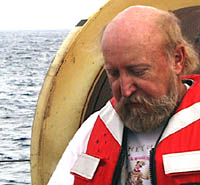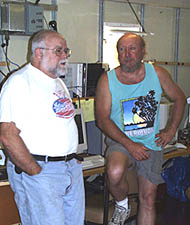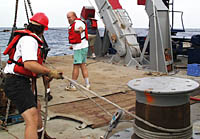|
|
Interviews: Ron Comer
Question:
When did you come to Scripps as a technician? Ron: When I decided to leave the oil business because I was never home, I contacted people at SIO that I met during my studies there. I was immediately hired, and 10 days later on a plane to Singapore. I was told to get on the RV Thomas Washington and stay on it until it got back to San Diego, some 3 1/2 months later. So much for being home more often! That was in 1977, and I have been sailing as a Resident Marine Technician ever since then. Question: What are the duties of the Resident Technician on board a Scripps research ship? Ron: We are the primary liaison between the science party and the ship’s crew. My duties include loading and stowing the scientific equipment for this expedition, and unloading and shipping the equipment out of Mexico at the end of the trip. I serve as the deck Safety Officer, and I am in charge of the launching and recovery of all over-the-side equipment. This includes rock dredges, rock corers, CTDs, and associated towed camera and mapping systems. I am also responsible for all samples and data; and ensure that they are archived and safely returned to their respective universities. This particular trip we have a new Resident Technician, Randy Dickau, who will be learning how to do all of these tasks.
What type of cruises do you enjoy the most? Ron: Geological sampling cruises usually are the most enjoyable. A lot depends on the weather and the people involved. My most memorable cruises took place in the late 1980’s and early 1990’s with Dr. Harmon Craig. We did much work on islands and volcanoes throughout the South Pacific collecting rock, gas, and water samples from fumaroles inside the volcanoes. Many of these islands are uninhabited and you get a real sense of excitement wondering if you were the first person there. Rock dredging has also provided some interesting finds of unique sulfide and rare minerals, as well as 2 live lobsters dredged up in the Indian Ocean (no -- we didn’t eat them!). Question: How much time do you spend at sea in a year? Ron: A typical year will include 6 or 7 cruises on any of Scripps’ four ships; that adds up to 150 to 180 days at sea. We have 7 technicians in our group, and SIO policy is that a Resident Technician must be on board for each cruise. We also hire out as technicians on other institutions’ vessels or even on foreign ships. Question: What are your duties on shore? Ron: Unlike the ship’s crew, we don’t earn time off for being at sea, so it is back to work on our return home. We maintain a shop where our ships are docked, and we are constantly loading, unloading, and storing equipment for various cruises. We maintain all of SIO’s geologic sampling equipment and a large amount of other sampling gear. We perform maintenance, sea preparation, and actually design and build some of our equipment. We rent out a lot of gear to scientists around the world for use on other research vessels. So there is a lot of shipping and receiving. We also stage equipment for upcoming expeditions. We operate cranes, fork lifts, and winches at sea and on shore. We spend a lot of time in preparation, meetings, and correspondence in planning cruises with individual scientists so they can make full use of the ship time that they have. We also maintain a number of small boats, and operate them for various tasks at sea and around San Diego’s bay and shoreline. We also scuba dive for bottom inspections, and to install or remove equipment that is attached to the hulls of our ships. Question: Could you relate any amusing incidents that happened during your many cruises? Ron: I remember, quite well, the time when we landed on the remnants of an old volcano, which is now a series of protruding rocks making up 7 or 8 very small islands, just NW of the Gambiers, an island group in the South Pacific. I was the first one out of the Avon boat, and positioned myself with one foot on a boulder and one foot in a tidal pool about 18 inches deep. I was preparing to receive the equipment from the boat when I felt something grab my leg. I looked down, let out a large yell, and jumped about 2 feet in the air! Evidently, I had disturbed the home of a 2 1/2 foot octopus. When I jumped, he let go and climbed up the rocks out of the water. Unfortunately for him, we later captured him and the cooks served him for dinner! Another time, we were on an active volcano and we could not get off due to the tide rising during the day. The small boat that came to pick us up could get within only about 30 yards of the rocky shore line. We were prepared for this problem if it came up. The Bosun in the boat threw us a line with 2 inner tubes attached. The problem we didn’t foresee was his report of 7 to 10 reef sharks swimming under the boat! Two of us finally mustered up our courage, waited for the proper moment of an incoming wave, and jumped into the sea. We were holding our rocks and equipment, and had the inner tubes tied together and around our waists. We made it okay, but after witnessing our escapade, the other 2 scientists waited another 45 minutes before they would take the plunge. All turned out fine and we were off to new adventures.
|
||||||
|
|
|||||||
© 2010 Dive and Discover™. Dive and Discover™ is a registered trademark of
Woods
Hole Oceanographic Institution



